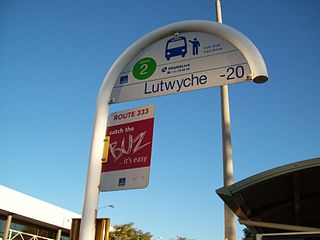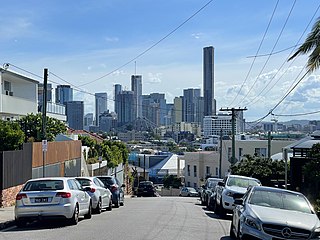
Transport for Brisbane, previously called Brisbane Transport, is an organisational division of the Brisbane City Council, responsible through its related Council Committee for providing policy and advice to Brisbane City Council, and for delivering various public transport services across the City of Brisbane. The division does this as part of an agreement with Translink, an agency of the Department of Transport and Main Roads that operates public transport across South East Queensland.

The South East Busway is a grade separated bus-only road running south from the Brisbane central business district to Eight Mile Plains in Queensland, Australia. The busway was completed to Woolloongabba in September 2000 and to Eight Mile Plains in April 2001. An extension of the busway to School Road at Rochedale was completed in 2014 with no additional busway stations. The maximum capacity of the busway is 18,000 commuters an hour during peak periods. The busway carries an estimated 70 million passengers annually.

The Volvo B12BLE is a low-entry city and suburban bus chassis launched in 2001 with a rear-mounted transverse engine. It superseded the Volvo B10BLE and is used as a base for single-decker buses in Europe and Australia.

Cultural Centre busway station is located in Brisbane, Australia serving the South Bank precinct. It is located directly south of Victoria Bridge and close to South Brisbane railway station.

First Hampshire & Dorset is a bus operator providing services in the counties of Hampshire and Dorset. It is a subsidiary of FirstGroup.

Bus upgrade zones, commonly abbreviated to BUZ, are a feature of Brisbane's public transport system. The name is given to high-frequency bus routes operated by Transport for Brisbane, the Brisbane City Council agency that operates the city's public bus services for Translink. All BUZ services run at least every fifteen minutes from around 6:00am to 11:30pm seven days a week and at least every ten minutes during peak hours from Monday to Friday.

Newstead is an inner northern riverside suburb of Brisbane, Queensland, Australia. In the 2021 census, Newstead had a population of 7,496 people.

Hillsbus was an Australian bus company that operated services in the Hills District of Sydney. Founded in 2004 when National Express merged its Glenorie Bus Company and Westbus subsidiaries, it was later part of ComfortDelGro Australia. In early 2023, the Hillsbus brand was replaced by ComfortDelGro's CDC NSW brand.

Teneriffe is an inner suburb of Brisbane, Queensland, Australia, 2.5 kilometres (1.6 mi) north-east of the CBD. In the 2021 census, Teneriffe had a population of 5,520 people.

Busways is an Australian bus company operating services in Sydney, and in the Central Coast, Mid North Coast regions of New South Wales and Adelaide. It is the largest privately owned bus operator in Australia.

Transport in Brisbane, the capital and largest city of Queensland, Australia, is provided by road, rail, river and bay ferries, footpaths, bike paths, sea and air.

The Brisbane tramway network served the city of Brisbane, Australia, between 1885 and 1969. It ran on standard gauge track. The electric system was originally energised to 500 volts, and subsequently increased to 600 volts. All tramcars built in Brisbane up to 1938 had an open design. This proved so popular, especially on hot summer nights, that the trams were used as fundraisers and often chartered right up until the last service by social groups.

South Notts Bus Company was a bus company operating in Nottinghamshire from 1926 until 1991 when sold to Nottingham City Transport who continue to use the brand name today.

Stagecoach East is a bus operator providing local and regional services across the East of England, operating in the counties of Bedfordshire and Cambridgeshire. The company is a subsidiary of the Stagecoach Group and is headquartered and registered in Cambridge.

Busways Travel Services was a bus operator formed in 1986 which operated local and regional bus services in Tyne and Wear, England. The company was purchased by the Stagecoach Group in July 1994.

Since the mid-1990s, a 27 kilometre bus rapid transit network has been developed in Brisbane, Australia. It comprises grade-separated bus-only corridors, complementing the Queensland Rail Citytrain network. Management of the busway network is the responsibility of Translink as coordinator of South East Queensland's integrated public transport system.
The Woolstore Precinct is a residential area in the suburb of Teneriffe in Brisbane, Queensland, Australia. A former industrial and commercial area, it has undergone urban renewal with preservation and re-purposing of many buildings from the early 20th century. This renewal has been guided by neighbourhood plans formulated by Brisbane City Council, with advice from the Queensland Heritage Council.
The BaT (Bus and Train) project was a proposed north–south tunnel that would provide bus and rail modes of transportation by combining a new underground rail line and busway in a single, double-decked, 15m-wide tunnel beneath the Brisbane River and Brisbane central business district. The tunnel was to have three underground stations at Woolloongabba, George Street and Roma Street with Dutton Park upgraded.

Brisbane Metro is a high-frequency bus rapid transit system that services the city of Brisbane in Queensland, Australia. It consists of two routes that will eventually run through the Brisbane CBD every three minutes during peak times (20bph), transporting up to 3,000 passengers per hour in each direction. The Metro temporarily operated a trial service on the 169 between UQ and Eight Miles plains between 21 October and 17 November. Metro Route M2 is expected to commence service on 28 January 2025 with the M1 route expected later in the same year.

The cuisine of Brisbane derives from mainstream Australian cuisine, as well as many cuisines of international origin, with major influences from Asian cuisine, European cuisine, and American cuisine that reflect the city's ethnic diversity, though Brisbane is represented by a wide range of other ethnic cuisines.




















